No Results Found
The page you requested could not be found. Try refining your search, or use the navigation above to locate the post.
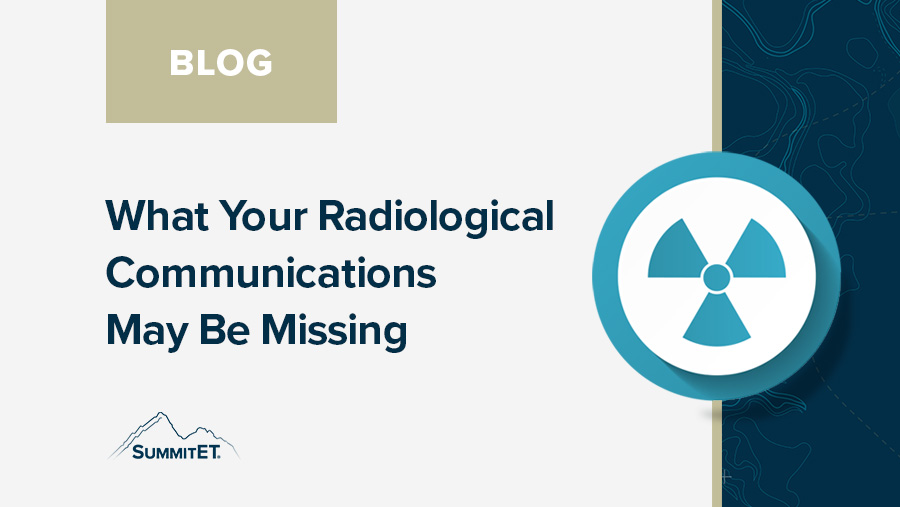
Details are important when developing messages. However, too many details can confuse the message or otherwise not make it as effective. When communicating technical subject matter such as that associated with a radiological incident, it’s important to have a good team to effectively communicate messages to the public.
Recently, I was approached by a friend asking about the radiation effects that may be associated with a medical procedure he had not long ago. This isn’t the first time that this has happened, nor do I expect it to be the last time it happens. This time, however, it made me start thinking about how we talk about radiation – not only with respect to medical procedures, but in general. In this particular instance a four gray radiation dose was delivered to the finger in 6 different treatments that happened over a several week time period.
Now, let’s take a timeout for a little health physics lesson. The term ‘radiation dose’ refers to how much energy is deposited into something. Its unit of measure is the rad (used in the US) or the gray (used internationally). Radioactive materials emit various types of radiation, and when that radiation interacts with something (tissue, for example) it deposits its energy into it. This isn’t dissimilar from when someone flicks your ear…when their finger interacts with your ear it deposits energy to the area it impacts.
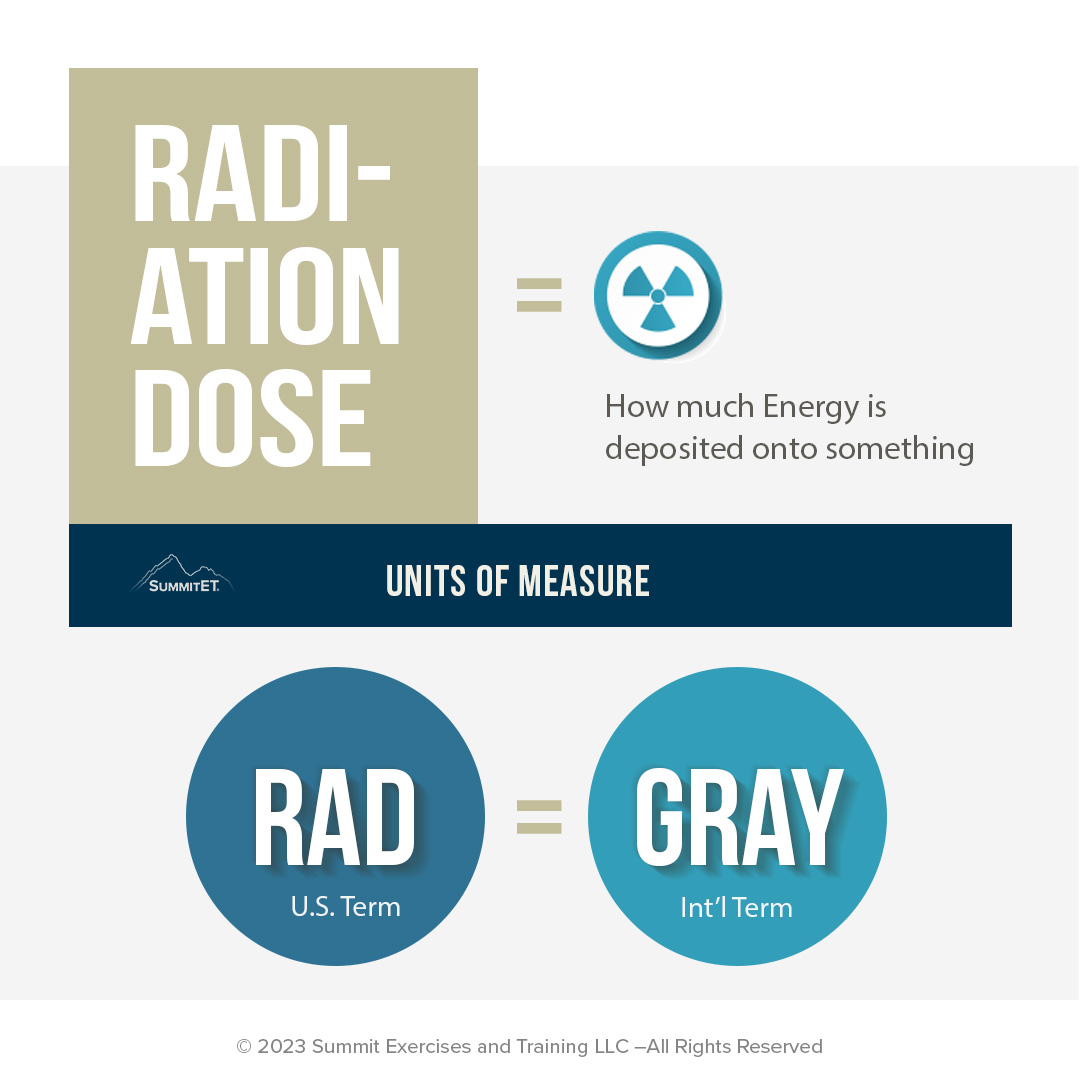
So, now, back to the question at hand: Is the four gray radiation dose from the medical procedure something my friend should be worried about? Before I get to the answer, let’s frame the question a little more generally without the details: Should I be worried about a radiation dose of 4 gray? That doesn’t sound like it’s a very different question, does it? Well, it is…and the details matter.
There are several things we need to know before we can answer the question the way it is presented in the general way, above. I always ask myself three questions when trying to figure out what the potential effects of a radiation dose may be:
The first question is, “How much?” Early (or acute) radiation effects are largely driven by how much radiation dose was delivered in conjunction with the answers to the other questions.
“How fast?” is the second question. The rate at which the radiation dose is delivered – or the time over which it’s spread – is important. A radiation dose that may result in early effects if delivered over a short period won’t necessarily result in early effects if it’s delivered over a longer period of time.
The third question is, “Where?” Getting flicked in the ear may be annoying, but getting flicked in the eye hurts. So, the same “flick” to a different area makes a difference. In other words, where the energy is delivered is important. A four gray (How much?) dose delivered to the blood forming organs in the gut over a short period of time may very well be be fatal without medical intervention. A four gray dose delivered over a short period of time to the back of the hand may result in some short-term hair loss in the affected area, but it wouldn’t be life-threatening. As you can see, the “Where?” question is very important and results in a very different outcome.
Physicians regularly deliver cumulative doses much greater than four gray to cancer patients via methods including external beam therapy and high dose rate brachytherapy. Those doses are fractionated over the course of the treatment largely for patient survival reasons. If the four gray dose to the back of the hand described above was protracted or delivered in fractions, temporary hair loss would not likely be of concern. Both of these examples are associated with the “How fast?” question.
So, to answer the question posed by my friend: Since the dose was delivered to the finger incrementally over a period of time, and it’s below the threshold where I would expect to see anything serious even if the dose was delivered all at one time, I don’t think he has to worry about early effects. Because the dose was delivered to a very small area, and taking his age into account, I think the risk for long-term concerns are exceedingly small. His physician told him essentially the same thing.
So, let’s get to the meat of this blog. If you are responsible for communicating information about radioactive materials or radiation, it is essential you understand the impacts details can have on the message.Too often I see articles or hear reports about radiation incidents – big and small – that make me wonder if the person delivering the message really understands the issue. Oftentimes, it’s probably due to an incomplete understanding of the situation and the effect small details may have. Likely, public information professionals may not know to ask the detail-oriented questions unless they have established a relationship with a technical expert to assist with public messaging.
It’s simple to search the internet for – in our example – the biological effects of a four gray dose. However, a simple question such as “Is a four gray radiation dose dangerous?” can have different answers based on the details of the situation. It’s not necessarily so simple to understand what your search results may turn up or whether the information is reliable, or not. Good public communications require more than simply ensuring a message is reviewed by the public affairs office or doing a quick internet search to gather “facts.” When the topic is something like potential radiation effects, it requires the integration of subject matter expertise into the message development process to ensure the message is appropriate for the situation.
And let’s be honest, in general, technically oriented people such as health physicists, engineers, etc., aren’t necessarily known for their communication skills. It is easy to overlook the fact that for a radiation protection professional to be effective at helping a communicator, he/she should receive training related to the public communications strategy. Details matter, but some matter more than others as one moves through the message development and public communication process.
Yes, details matter, but it’s easy to fall into the trap of trying to be 100% correct yet losing “understandability.” Keep in mind an effective message must not only be correct, but understandable. A key question to ask is “How correct is correct enough?” I encourage radiation protection professionals who may be tasked with assisting communicators to seek out training and/or to further hone their communication skills. Equally importantly, if not more so, I encourage those public affairs and public information professionals responsible for communicating radiological information to identify radiation professionals who can assist and integrate them into the communication process by setting expectations and providing necessary training. This should not be done after “it’s hit the fan,” but well before so that determinations can be made about your radiation expert’s ability to provide proper communications assistance or to identify areas where further training may be needed.
Our brains crave meaning before detail. Details are important, but oversaturation of technical jargon and concepts may negatively affect the understanding of your message by a non-technical audience. Addressing questions such as, “Will it hurt me?” or “Am I in danger?” come first before the technical details. A well-rounded communications team can help ensure your messages are not overly technical and remain understandable. A good internal team consisting of both public information professionals and radiological subject matter experts can most effectively communicate your messages to the public.

VP of Operations & Corporate Health Physicist
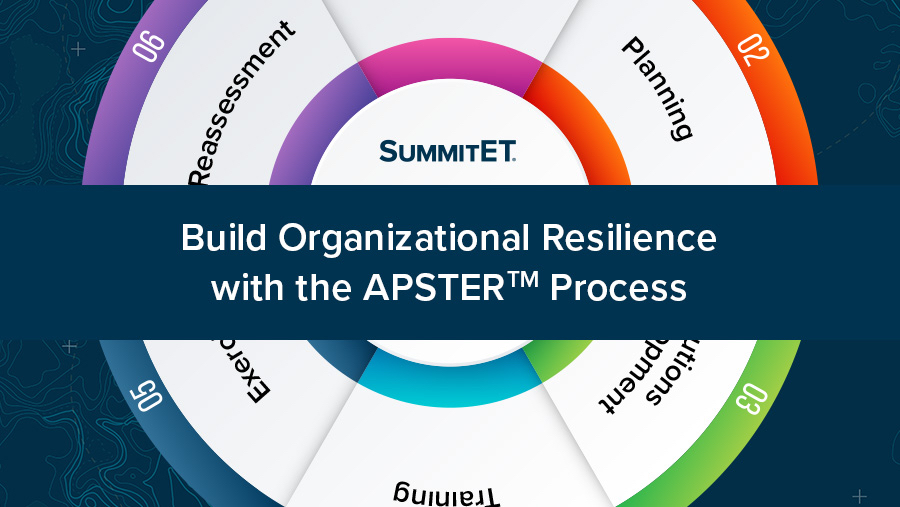
Utilizing industry experts in crisis and emergency management and leveraging our scientific and technical expertise, SummitET’s communication team can build a comprehensive solution to address any organization’s current or emerging threats. By highlighting an organization’s competency through training and exercises, our team can build upon this foundation to minimize any vulnerabilities discovered through this process.
COVID-19 has changed the threat paradigm organizations face which is why critical thinking and preparation for any possible threat that can disrupt continuity of operations, must be considered. Our Team has developed the APSTERTM process which addresses six critical tenants to comprehensively prepare organizations for these unforeseen events:
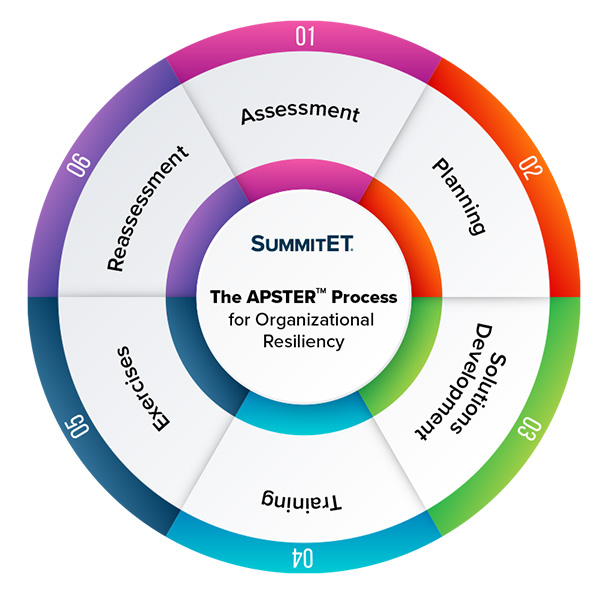
Our assessment process methodically identifies the highest potential risk an organization may face and aggregates evaluated outcomes from those potential threats. The APSTERTM process uses a 3X3 innovation risk matrix to visualize the probabilities of such risks occurring and the severity of consequences should they impact the organization.
This 3X3 Innovation Risk Matrix:
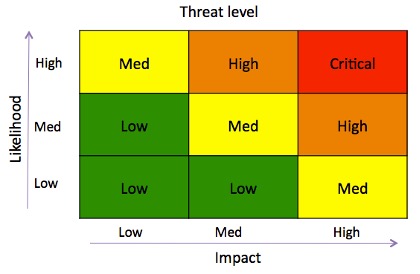
Our planning approach not only effectively aligns itself with the organization’s strategic goals and objectives, but also the less tangible corporate culture and environment. These planning considerations help capitalize on the existing talents and strengths an organization possesses while exposing the less obvious vulnerabilities and organization may overlook.
Figure 1.3 symbolizes one of the many planning methodologies models which can be integrated into the APSTERTM process.
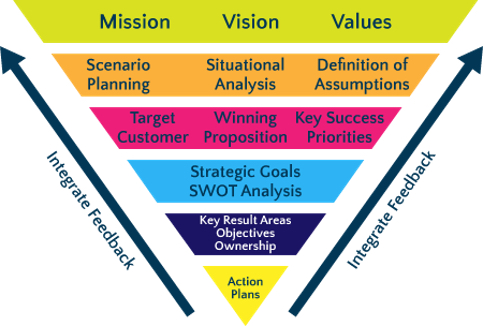
Our approach to developing impactful and resilient solutions focused on our client’s ideation from our Assessment and Planning processes produces alternative solutions, selects best solutions, and informs plans for implementation and integration into existing business practices.

Initiating and incorporating these solutions into the corporate culture starts with effective and impactful training. Training benefits organizations through maintaining, enhancing, and increasing:
The strategic communications APSTERTM process utilizes the educationally proven ADDIE methodology to assist organizations with identifying training deficiencies. The ADDIE method is a fivefold process: (1) Analysis, (2) Design, (3) Development, (4) Implementation, and (5) Evaluation. Figure 1.4 defines each ADDIE component.
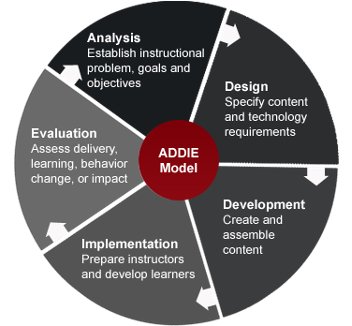
In parallel with current government and industry practices, SummitET’s Strategic Communications Program phases an effect exercise program to stress the organization’s strengths and vulnerabilities. Evaluating and capturing critical data points, our approach reinforces the strengths of the organization and capitalizes on the weakness and failures these exercises present. To fail or expose organizational weaknesses presents an opportunity to grow and is a very important part of the APSTERTM process. The outcome from these exercises leads the organization into the importance of the “Reassessment” tenant, which incorporates a continuous improvement process that methodically reduces the probability and the consequences of those risks, while promoting preparedness through awareness and continuously enhancing the state of resilience.
SummitET’s Strategic Communications Program conducts three types of exercises, (1) drills, (2) Tabletops (TTX), and (3) Full-scale exercises (FSE). Exercises reinforce issues such as response preparedness, adequacy of plans and procedures, and validation of personnel and equipment. Exercises are SummitET’s premier, most highly sought-after client service. Integrating the APSTERTM process ensures SummitET’s methodology in the design, development, and implementation is well-thought out, deliberate, and focused on organizational needs and requirements. Figure 1.5, Exercise Program Management, serves as an example of the exercise planning process.
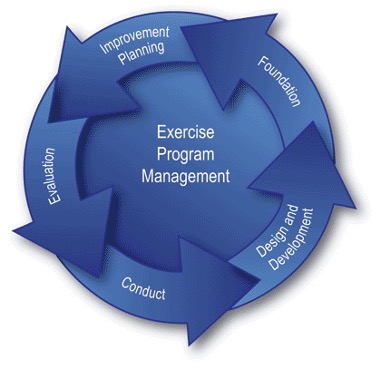
Our reassessment process methodically addresses three key areas: (1) gap-analysis, (2) lessons learned, and (3) best practices.
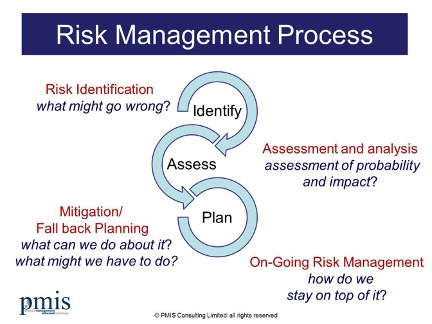
By design, the APSTERTM process employs an innovative academic approach by using the industry’s leading experts, cutting edge industry practices, proven scientific and technical methodologies, making our process not only unique, but the most effective solution on the market to make your organization prepared and resilient against current or emerging threats.
As emergency management and preparedness continues to evolve, our Strategic Communications team’s APSTERTM process addresses (1) organizational resiliency, (2) continuity of operations, and (3) continuous improvement efforts.
The APSTERTM Process
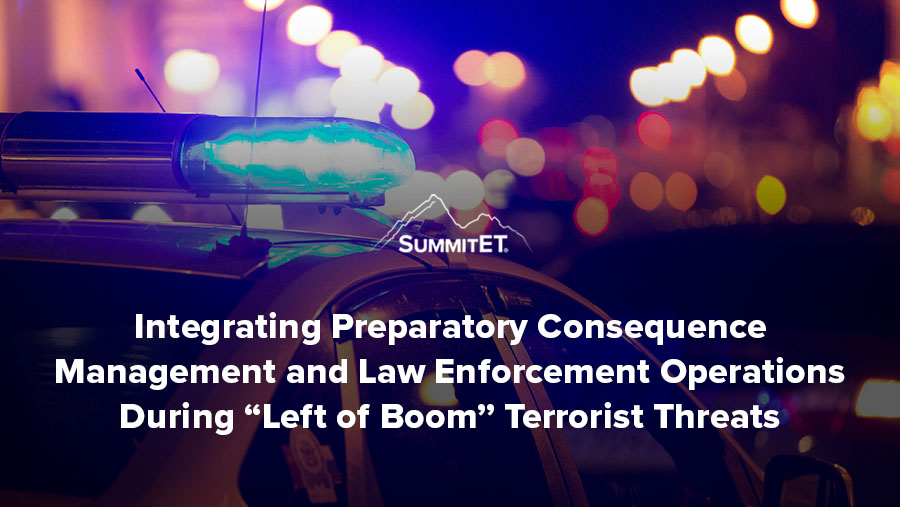
National policy now treats consequence management and law enforcement operations as a single integrated function. However, responding to an imminent terrorist threat, particularly one involving a weapon of mass destruction, is more complex than responding to an impending natural disaster. If the government conducts highly visible preparatory consequence management operations, a terrorist could be alerted, which could potentially jeopardize the government’s efforts to stop the terrorist. This article offers a new planning approach enabling all levels of government to integrate cohesively their operations to maximize their ability to stop the terrorist while minimizing the potential consequences if those efforts are unsuccessful.
This article was originally published at https://www.hsaj.org/articles/21159
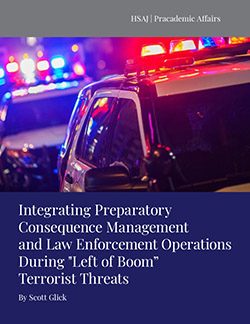
Glick, Scott. “Integrating Preparatory Consequence Management and Law Enforcement Operations During “Left of Boom” Terrorist Threats,” Homeland Security Affairs: Pracademic Affairs 2, Article 3, (July 2022). www.hsaj.org/articles/21159.
“Mother Nature” does not care if the nation is prepared for a hurricane. However, if the government is aware of a terrorist threat, but the public is not aware of that threat, and the government conducts highly visible preparatory consequence management operations, then an alerted terrorist could change tactics or attack a different target. To avoid this potential “no-win” scenario, response and prevention mission planners across all levels of government must consider the unique and complicating factors that can adversely affect their mission’s success during credible terrorist threats, particularly those involving a weapon of mass destruction (WMD). This article builds on my previous writing in “Preparatory Consequence Management & Weapons of Mass Destruction”[1] and proposes a new way to bridge a planning gap that currently exists in national planning guidance. If federal, state, local, tribal and territorial (FSLTT) officials adopt this new approach and cohesively integrate preparatory consequence management operations and law enforcement operations across all levels of government for “left of boom” terrorist threats, they will maximize their ability to stop the terrorist while minimizing the potential consequences of the terrorist’s actions.
To ensure the government’s natural disaster response is not “late to need,”[2] dedicated specialists can use analytical tools to issue guidance[3] that can lead to a range of preparatory consequence management actions taken in the days and hours leading up to the event. Consequence management planners design their operations to maximize the government’s ability to protect public health and safety, restore government services, meet basic human needs, and provide emergency relief to those affected by an incident.[4] These operations, which are part of the federal government’s response mission, are led by the U.S. Department of Homeland Security (DHS), acting through the Federal Emergency Management Agency (FEMA).[5]
By way of contrast, the federal government’s prevention mission operations – which include law enforcement and/or counterterrorism operations and are sometimes referred to as “crisis management”[6] operations – are led by the U.S. Department of Justice (DOJ), acting through the Federal Bureau of Investigation (FBI). The prevention mission’s focus is different. The primary focus is to avoid, prevent or stop a threatened or actual act of terrorism.[7] However, while “Mother Nature” does not care if the public is warned and prepared before an impending natural disaster, profoundly different considerations are present when the government is confronted with a terrorist threat and the public is not aware of that threat. Unlike nature’s indifference to preparations and warnings, if the government conducts highly visible preparatory consequence management operations, it could alert the terrorist and therefore adversely affect the success of the prevention mission.[8]
The National Response Framework (NRF)[9] and the Response Federal Interagency Operational Plan guide response and prevention planners and direct them to integrate and synchronize their operations. These planning documents emphasize establishing “joint priorities, particularly in areas such as incident site/crime scene access, pre-positioning, operations to resolve threats, public information and warning, and fatalities management.”[10] Since the response mission focuses on saving lives as well as protecting property, critical infrastructure, and/or the environment after an incident,[11] how to achieve unity of effort with the prevention mission before a terrorist incident is not addressed in the NRF or the response FIOP. Indeed, while the goal is to “simultaneously save lives, investigate and resolve threats, and/or prevent follow-on attacks,”[12] these planning documents do not provide specific planning guidance.
The National Prevention Framework (NPF) defines imminent terrorist threats to be when “intelligence or operational information warns of a credible, specific, and impending terrorist threat … that is sufficiently specific and credible to recommend implementation of additional measures to thwart the attack.”[13] It then notes that an imminent terrorist threat may “emerge at any time and become known through one of several different vectors: the U.S. intelligence community, federal, state or local law enforcement, or the American public.”[14] Understanding this point raises the following important question: what if the knowledge of an impending terrorist attack is only within the government? Moreover, how should the federal government and/or its SLTT partners respond to a “left of boom” WMD terrorist threat when the public is unaware of the threat? Terrorists may “select soft targets or other vulnerable environments to maximize casualties.”[15] Because of this, forward-leaning response planners must consider that highly visible response operations may cause terrorists to “strike quickly and move to another location before law enforcement can interdict and disrupt.”[16]
FSLTT officials need a new way to integrate cohesively preparatory consequence management operations and law enforcement operations during “left of boom” terrorist threats when the public is not aware of the threat, particularly those that involve a WMD. This article proposes that response and prevention planners across all levels of government use the new approach discussed below to develop comprehensive and integrated plans that will enable them to maximize their ability to stop the terrorist, while simultaneously minimizing the potential loss of life, damage to property, critical infrastructure, and the environment.
There are three key elements to developing a plan that will cohesively integrate prevention and response mission operations when the public is not aware of a WMD terrorist threat: dividing response options into operational phases, using an OPSEC (operational security) construct to analyze activities during those phases, and attention to critical considerations.
When the response mission leans forward for impending natural disasters, the instinct is to “go big, go early.”[17] However, if a goal is not to alert the terrorist, this approach presents a potential conflict. In the same way that public disclosure of a spy’s activities could cause the spy’s cover to be “blown,” the more significant the public visibility of the preparatory consequence management operations, the greater the likelihood of alerting threat actors and adversely affecting the success of the prevention mission. Yet, without a robust ability to lean forward, particularly for threats involving a WMD,[18] the response mission’s ability to succeed may be adversely affected.
Under President G.W. Bush’s direction, Homeland Security Presidential Directive 5, Management of Domestic Incidents (2003), developed the National Incident Management System (NIMS) and emphasized the importance that all levels of government use shared structures, systems, processes, and vocabulary to guide response personnel.[19] NIMS defines a “staging area” as a “temporary location for available resources in which personnel, supplies, and equipment await operational assignment.”[20] If we were to think about “staging” as one part of an operation and then were to think about the other phases, the following four operational phases emerge:
Although we divided response operations into four phases, we still need to address the instinct to “go big, go early.” Here we can look to the concept of OPSEC which the U.S. government has long considered as a critical planning construct for sensitive operations. OPSEC involves the “implementation of procedures and activities to protect sensitive or classified operations.”[21] By following OPSEC principles, the FSLTT government officials can deny a potential adversary information about the government’s intentions. Thus, if we were to view each of the four operational phases listed above through an OPSEC construct, we can think about the public visibility of each phase of each potential preparatory consequence management action and assess how likely that phase of that action would be to alert the terrorist.
The success of the response mission is critically important. In this regard, the response FIOP notes the importance of looking at “interdependencies.”[22] An interdependency exists when the execution of one part of an operation depends upon another part being executed. Stated another way, the failure of one part of a response operation could very well affect the success of the entire response operation. Interdependencies, however, can be “pooled, sequential or reciprocal.”[23] For example, let’s assume that medical countermeasures are needed to save lives. However, this effort’s success depends on delivering and administering medical countermeasures by personnel to the affected population.[24] Thus, interdependencies that could affect the success of the response mission’s operations must be considered.
In addition to understanding interdependencies, other considerations, such as time must also be taken into account. For example, the time needed to go from the alert and activation phase to the deployment and employment phase is a critical consideration for response planners, as illustrated by this example noted by the Centers for Disease Control and Prevention (CDC). If someone has symptoms of anthrax infection, the CDC notes that it is critical to get them medical care “as quickly as possible.”[25] Indeed, the CDC points out that certain antibiotics can “prevent anthrax from developing in people who have been exposed but have not developed symptoms.”[26] Thus, as the response FIOP emphasizes, prevention and response decision-makers “must be in communication during times of an imminent threat so that response assets, to the extent practical and appropriate, may be pre-positioned.”[27] However, while pre-positioning medical countermeasures is a necessary first step, these planners also need to factor in the time it will take to distribute and administer those medical countermeasures to the population.
Planners must also consider the cumulative effect that preparatory consequence management actions could have on the overall public visibility of the response operations. For example, a few consequence management actions may be unlikely to alert a threat actor when viewed in isolation. However, if numerous such actions all were to happen in the same place at the same time, their cumulative effect could very well alert a threat actor.
Another critical consideration is the dynamic nature of some terrorist threat scenarios. Concerns about potentially compromising prevention operations could change as the facts and circumstances evolve, including if the public becomes more aware of the threat. As the federal government has emphasized, “suspected or actual involvement of terrorists adds a complicating dimension to incident management.”[28] Thus, whereas a public warning may be inadvisable at a certain point in time, evolving circumstances, including media disclosures, may indicate that such warnings or other publicly visible actions may be advisable.[29]
Guidance from the DHS’s Planning Considerations: Complex Coordinated Terrorist Attacks (CTTA) states that terrorists may select “soft targets or other vulnerable environments to maximize casualties,” and may move to a new target “before law enforcement can interdict and disrupt.”[30] As the CCTA guidance notes, one of the “major challenges” of responding to terrorist attacks is the integration of “crisis management (e.g., law enforcement, interdiction), consequence management (e.g., emergency management), and investigatory functions (e.g., evidence gathering, forensics, attribution). All must be performed simultaneously and involve entities that may not habitually operate together.”[31]
The CCTA guidance, like the NRF and the response FIOP, focuses on “right of boom.” Nonetheless, and building on FEMA’s multi-step planning process,[32] which is already well known to FSLTT planners, the CCTA guidance provides a roadmap for them to develop a plan to address “left of boom” terrorist threats when the public is not aware of the terrorist threat. The following steps are therefore recommended for response planners to ensure the development of a comprehensive plan that will lead to risk-informed decisions.
The seven planning steps discussed above need to involve all levels of government to maximize the chances for the success for both prevention and response missions, particularly for terrorist threats involving chemical, biological, radiological, and nuclear (CBRN) materials, weapons, and/or dispersal devices. For example, the federal government has a new interagency coordination mechanism for coordinating the federal government’s response to WMD terrorist threats, namely, the Weapons of Mass Destruction Strategy Group (WMDSG).[34] The WMDSG is an FBI-led interagency crisis action team supporting information exchange and the deconfliction of consequence management and law enforcement operations.[35] The federal government co-locates the Consequence Management Coordination Unit (staffed and managed by FEMA) directly in the WMDSG. This allows “real-time” information sharing, strategic advice, and recommended consequence management courses of action that can take into account ongoing law enforcement and counterterrorism operations.[36] SLTT governments should mirror this approach and co-locate and integrate law enforcement and consequence management operations.
Indeed, as the federal government has pointed out, it cannot combat WMD terrorism alone. As a result, the federal government’s response to a terrorist threat may need to be augmented by assets and resources under the control of SLTT governments.[37] These may be tasked with locating the terrorist and the weapon the terrorist intends to use to carry out the attack or to assist in mitigating the potential consequences of the threat. For example, let us assume a terrorist threatens to use a WMD. The National Guard has 57 WMD-civil support teams across the country. These civil support teams can “identify chemical, biological, radiological and nuclear agents and substances, assess current and projected consequences, advise on response measures, and assist with requests for additional support.”[38]
Similarly, SLTT public health resources may be needed to augment the distribution and administration of medical countermeasures or to otherwise prepare for mass casualty events, as illustrated by the federal government’s delivery of Covid-19 vaccines to “loading docks” that needed states and localities to “take over from there.”[39] An act of terrorism involving CBRN materials that may “overwhelm the capabilities of many local, state and/or tribal governments to respond” may also “seriously challenge existing Federal response capabilities.”[40] As a result, unity of effort will be required, which mandates the seamless integration of law enforcement and consequence management operations. In the same way that unity of effort was improved through the adoption of NIMS, the federal government and its SLTT partners should adopt the new approach discussed above to develop a cohesive plan for integrating preparatory consequence management and law enforcement operations during “left of boom” terrorist threats when the public is not aware of the threat, particularly for those involving the threatened use of a WMD.
Finally, while some preparatory consequence management actions can alert a terrorist and adversely affect the prevention operations, response planners may nonetheless recommend those actions to decision-makers to minimize the potential negative effect on the mission. While these recommendations may raise difficult discussions and require difficult decisions, senior government officials must also consider the success of the response.
Since 2003, national policy has treated law enforcement crisis management operations and consequence management as a single integrated function.[41] However, responding to terrorist threats can be more complicated than responding to natural disasters. Moreover, when a terrorist is threatening the use of a WMD, effective response can be even more complex because of the unique challenges that exist in responding to threats involving CBRN materials, dispersal devices, and weapons.[42] If the public is not aware of the terrorist threat and the government conducts highly visible preparatory consequence management operations, the terrorist could be alerted, potentially jeopardizing the success of the prevention mission’s efforts. At the same time, it is essential to consider interdependencies and other factors that can affect the success of the response mission’s efforts.
All levels of government must adopt a unified approach that cohesively integrates preparatory consequence management and law enforcement operations during “left of boom” terrorist threats. The successful resolution of imminent terrorist threats will require more than cohesive and integrated planning and operations. Senior government officials may need to make tough decisions involving competing risk and value trade-offs. To best support them, the federal government’s and SLTT government’s approach to “left of boom” terrorist threats and the coordination mechanisms should be similar and integrate seamlessly. This will ensure that decision-makers across all levels of government have the same understanding of the threat and that course of action options are developed with the risk-informed input from stakeholders in all mission areas.
Scott J. Glick is vice president and general counsel for Summit Exercises and Training LLC (SummitET®), a veteran-owned small business that specializes in providing proven preparedness solutions to systematically address all threats and hazards through a wide range of services, including planning, training, and exercises, as well as operational and policy support, for its government and private sector clients. He has four decades of experience in law enforcement, counterterrorism, critical incident response, exercises, and emergency preparedness. He previously served as the director of preparedness and response and senior counsel in the National Security Division at the U.S. Department of Justice (DOJ), where he led DOJ’s national preparedness policy and planning efforts, including in regard to countering weapons of mass destruction. He has investigated and prosecuted international terrorism cases as a federal prosecutor, and organized crime cases as a state prosecutor in New York. Since his retirement from DOJ, he has provided substantial advice and guidance to numerous federal departments and agencies on the cohesive integration of law enforcement, counterterrorism, and consequence management operations in response to terrorist threats. This article contains no classified or confidential government or business information, and the views expressed in this article are solely those of the author and do not necessarily represent the views of any government department or agency, or any private sector company.

[1] Scott J. Glick, Preparatory Consequence Management & Weapons of Mass Destruction, DomPrep Journal (November 2020), https://www.domesticpreparedness.com/preparedness/preparatory-consequence-management-weapons-of-mass-destruction/.
[2] Karen Roganov, FEMA, State, Military, Guard, CAP, Volunteers, Rehearse Whole-of-Government Crisis Response, Joint Task Force Civil Support News (June 18, 2019), https://www.jtfcs.northcom.mil/MEDIA/NEWS-ARTICLES/Article/1879772/fema-state-military-guard-cap-volunteers-rehearse-whole-of-government-crisis-re/.
[3] E.g., “Severe T-Storms Prompt Tornado Watch in Parts of Tri-State Area,” WCBS NewsRadio 880 (August 27, 2020), https://www.audacy.com/wcbs880/articles/news/cuomo-ny-agencies-to-pre-deploy-emergency-response-assets.
[4] FEMA Mission Areas and Core Capabilities, (Last updated July 20, 2020), https://www.fema.gov/emergency-managers/national-preparedness/mission-core-capabilities.
[5] PDD-62, Protection Against Unconventional Threats to the Homeland and Americans Overseas, at 5-6 (May 22, 1998) (“When the Attorney General, acting on the advice of the Director, FBI, and in coordination with the Director, FEMA, determines that the incident or threat of an incident has subsided, lead agency responsibility may be transferred to FEMA.”), https://clinton.presidentiallibraries.us/items/show/16200.
[6] Presidential Decision Directive (PDD) 39, U.S. Counterterrorism Policy, 6, (June 21, 1995), (“Within the United States, the Department of Justice, acting through the FBI, shall have lead responsibility for management of terrorist incidents,” https://clinton.presidentiallibraries.us/items/show/12755.
[7] National Prevention Framework, 1, (2d Ed. 2016), https://www.fema.gov/sites/default/files/2020-04/National_Prevention_Framework2nd-june2016.pdf.
[8] Scott J. Glick, Preparatory Consequence Management & Weapons of Mass Destruction, DomPrep Journal (November 2020), https://www.domesticpreparedness.com/preparedness/preparatory-consequence-management-weapons-of-mass-destruction/.
[9] National Response Framework, 2, (4th Ed. 2019), https://www.fema.gov/sites/default/files/2020-04/NRF_FINALApproved_2011028.pdf.
[10] Response FIOP, 5, (2d Ed. 2016), https://www.fema.gov/sites/default/files/documents/fema_response-fiop.pdf .
[11] National Response Framework, 12, (4th Ed. 2019), https://www.fema.gov/sites/default/files/2020-04/NRF_FINALApproved_2011028.pdf.
[12] Ibid.
[13] National Prevention Framework, 3, (2d Ed. June 2016), https://www.fema.gov/sites/default/files/2020-04/National_Prevention_Framework2nd-june2016.pdf.
[14] Ibid., 3.
[15] DHS, Planning Considerations: Complex Coordinated Terrorist Attacks, 2, (July 2018), https://www.fema.gov/sites/default/files/2020-07/planning-considerations-complex-coordinated-terrorist-attacks.pdf.
[16] Ibid.; See also U.S. Department of State, International Travel, Terrorism (Listing recommendations for travelers to “avoid becoming a target of opportunity”), https://travel.state.gov/content/travel/en/international-travel/emergencies/terrorism.html.
[17] FEMA, Leaning Forward: Go Big, Go Early, Go Fast, Go Smart, https://www.fema.gov/pdf/about/state_of_fema/state_of_fema.pdf.
[18] Podcast: Spotlight on FEMA’s CBRN Office (November 29, 2019), https://cbrnecentral.com/the-fema-podcast-spotlight-on-femas-cbrn-office/21038/ (FEMA official noting “We’re always trying to lean forward in the CBRN realm as well.”).
[19] National Incident Management System (Third Ed. 2017), https://www.fema.gov/sites/default/files/2020-07/fema_nims_doctrine-2017.pdf. For a historical chronology of FEMA and the management of the consequences of terrorism from 1972 through 2009, see Baldwin, “FEMA’s Terrorism Consequences Role as Assigned by Section 2-103 of E.O. 12148,” https://fas.org/irp/agency/dhs/fema/chron.pdf.
[20] National Incident Management System, Glossary, 70, (3rd Ed. 2017), https://www.fema.gov/sites/default/files/2020-07/fema_nims_doctrine-2017.pdf.
[21] National Incident Management System, Glossary, 68, (3rd Ed. 2017), https://www.fema.gov/sites/default/files/2020-07/fema_nims_doctrine-2017.pdf.
[22] Ibid., 4.
[23] Profit Management Solutions, “How Are You Managing Your Team Interdependence,” (August 3, 2020), https://proffittmanagement.com/how-are-you-managing-your-team-interdependence/.
[24] Richard Sisk, “Shots in Arms Within 24 Hours: Army General’s Complex Vaccine Delivery Task Takes Shape,” Military News (October 26, 2020), https://www.military.com/daily-news/2020/10/26/shots-arms-within-24-hours-army-generals-complex-vaccine-delivery-task-takes-shape.html (large scale distribution of vaccines is complex from a “logistical standpoint).
[25] Centers for Disease Control and Prevention, Treatment of Anthrax Infection (Last reviewed November 20, 2020), https://www.cdc.gov/anthrax/treatment/index.html.
[26] Centers for Disease Control and Prevention, Antibiotics to Prevent Anthrax After Exposure, (Last reviewed November 20, 2020), https://www.cdc.gov/anthrax/prevention/antibiotics/index.html.
[27] Ibid., 5.
[28] FEMA, Terrorism Incident Law Enforcement and Investigation Annex, 3, (December 2004), https://www.fema.gov/sites/default/files/2020-07/fema_incident-annex_terrorism-law-enforcement.pdf.
[29] Connor Simpson, “F.B.I. Released the Tsarnavev’s Photos Because of Reddit and the Post,” The Atlantic (April 21, 2013), https://www.theatlantic.com/national/archive/2013/04/fbi-released-tsarnaev-brothers-photos-because-reddit-and-post/316075/.
[30] DHS, Planning Considerations: Complex Coordinated Terrorist Attacks, 2, (July 2018), https://www.fema.gov/sites/default/files/2020-07/planning-considerations-complex-coordinated-terrorist-attacks.pdf.
[31] Ibid.,3.
[32] FEMA, Developing and Maintaining Emergency Operations Plans: Comprehensive Preparedness Guide (CPG) 101, 43, (Ver. 3 2021), https://www.fema.gov/sites/default/files/documents/fema_cpg-101-v3-developing-maintaining-eops.pdf.
[33] Intelligence Community Directive (ICD) 203 (January 2, 2015) highlights the importance of expressing likelihood or using the same terminology (i.e., not mixing words with percentages). By thinking about each phase of each potential preparatory consequence management action and placing that action in a default category of its likelihood to alert the threat actor, Response and Prevention Mission planners can collectively, using the same terminology, effectively understand the degree to which each potential action could adversely affect the success of the Prevention Mission.
[34] U.S. Department of Homeland Security, Protection Federal Interagency Operational Plan (FIOP), First Edition, C-3-12, (January 2016), https://www.fema.gov/sites/default/files/documents/fema_protection-fiop.pdf; See also U.S. Department of Homeland Security, FIOP Response and Recovery, Oil/Chemical Incident Annex, 4-8, (June 2016), https://www.fema.gov/sites/default/files/2020-07/fema_incident-annex_oil-chemical.pdf.
[35] Ibid.
[36] FEMA, Protection Federal Interagency Operational Plan, Appendix C to Annex C, C.3-12, (1st ed. January 2016), https://www.fema.gov/sites/default/files/documents/fema_protection-fiop.pdf.
[37] National Strategy for Countering Weapons of Mass Destruction Terrorism, 11, (December 1, 2018), https://www.hsdl.org/?view&did=819382 (WMD terrorism cannot be “combatted exclusively by Federal authorities” and many others, including first responders, and health care professionals play a key role in protecting the nation against WMD threats).
[38] National Guard, Weapons of Mass Destruction (WMD) Civil Support Team (CST) (Current as of December 2017), https://www.nationalguard.mil/Portals/31/Resources/Fact%20Sheets/Weapons%20of%20Mass%20Destruction%20Civil%20Support%20Team%20Fact%20Sheet%20(Dec.%202017).pdf .
[39] Karen Weintraub and Elizabeth Weise, Analysis: What Went Wrong with COVID-19 Vaccine Distribution and How It Has Tarnished The ‘Miracle,’” USA Today (January 31, 2021), https://www.usatoday.com/story/news/health/2021/01/31/covid-vaccine-what-went-wrong-distribution-whats-being-changed/4275954001/.
[40] FEMA, Terrorism Incident Law Enforcement and Investigation Annex, 3, (December 2004), https://www.fema.gov/sites/default/files/2020-07/fema_incident-annex_terrorism-law-enforcement.pdf.
[41] Homeland Security Presidential Directive 5, para. 3, Management of Domestic Incidents (February 23, 2003).
[42] FEMA, Federal Interagency Operational Plans, (Last updated April 30, 2021), https://www.fema.gov/emergency-managers/national-preparedness/frameworks/federal-interagency-operational-plans.
Copyright © 2022 by the author(s).

It is important for nuclear power plants and Offsite Response Organizations (OROs) to develop and practice effective strategic communication to meet training and exercise requirements such as:
Response to COVID-19 has presented challenges in meeting training and exercise requirements since many in-person activities are not an option, however, a successful pivot from in-person to virtual engagements will allow nuclear power plants and ORO’s to continue to meet customer’s mission requirements.
To meet regulatory requirements as outlined in 10 CFR 50.47(b)(7); 44 CFR 350.5(a)(7), emergency preparedness and response training and exercise activities are conducted to ensure public education and information meet planning standards and evaluation criteria. Due to the inability of many nuclear power plants and OROs to hold in-person training and exercises, this requirement calls for an alternative approach. According to NUREG-0654/FEMA-REP-1, Rev. 2, “Alternative approaches provide an opportunity for state, local, and tribal governments, applicants, and licensees to meet the planning standards in a manner that is different from what the evaluation criteria recommend…”
These training and exercise solutions enhance strategic communication and address CERC principles such as effectiveness, consistency, and proficiency for a FEMA-evaluated exercise and when communicating technical information to non-technical audiences.
SummitET’s Strategic Communications Program offers exercise solutions and training presented through The Strategic Communications Institute for Preparedness® (SCIP), delivered by experts, including a Certified Health Physicist, with extensive knowledge of the unique challenges presented by a radiation emergency.
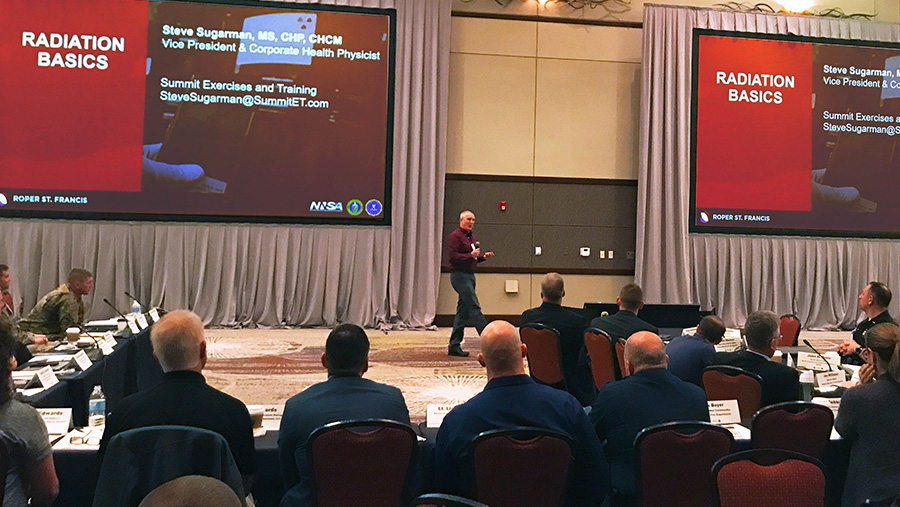
Original Post HPS News
Steve Sugarman*, MS, CHP, SummitET Vice President and Corporate Health Physicist, SummitET.com
Acknowledgements: Mark Basnight, SummitET Vice President of Communications and Marketing; Holly Hardin, SummitET Strategic Communications Program Manager
The importance of effective communication cannot be overstated. Radiation can be a scary word. A lack of knowledge and/or not understanding how radiation works can lead people to make decisions they may not have made had they been more aware of the true nature of the potential hazard. As HPs, we play a key role in providing information and guidance to various stakeholders to help facilitate good decision-making.

Camden County HAZMAT vehicle outside Haddon Township High School, 1-8-21. Credit: Matt Skoufalos.
A recent example of an overreaction based on a lack of understanding of the relative hazard happened on 8 January 2021 in Haddon Township, New Jersey. A student brought a uranium-glazed plate (Fiesta® ware) and Geiger counter that he had been given for Christmas to school to show a teacher. As a result, Haddon Township High School was evacuated over radiation concerns. Agencies that responded to the scene included local law enforcement, fire, HAZMAT, and even representatives from the county prosecutor’s office. Unnecessary responses of this nature draw resources from areas where they may be needed, are expensive, negatively impact the involved institutions, create concern/fear for the public, and unintentionally increase risk to evacuees—not to mention the overall risk associated with just responding to an incident.
It can be difficult to take a complicated topic and simplify it into easily understood terms while maintaining factual integrity. The implications of effective communications are far reaching—whether it is helping an individual who has radiation-related concerns about an anticipated medical procedure or affecting the public’s willingness to accept emergency-management recommendations during an incident involving radioactive materials. We should all hone our communication skills to help educate others about what radiation can and cannot do.
Let’s consider how we process risk. According to the late Dr. Dennis Mileti, who specialized in disaster communication, people pick the messages they want to hear. For example, in regard to the COVID-19 pandemic, people will select what they want to hear about the need for masks, about the timeline for a vaccine, about social distancing, etc. Messages that motivate behavior change must consider emotion, social networks, and group identity—all important things to consider. We must understand people’s fears before we tell them what to do; make all public directives as specific, consistent, and clear as possible; and ensure messages come from many different sources when trust is rare. The pandemic has highlighted the distrust that mixed messages and mixed respect for experts can generate. These are not necessarily new issues, but they are certainly contributing to the complexity of the current information ecosystem.
Remember who your information consumers are—what modalities they use and what their preferences for information consumption are. While society evolves and we try to understand the vast diversity of culture, we can all agree that communication can be complex. Understand the emotional status of your audiences and tailor messages to address their fears and/or perceptions. Strong emotions are not likely to be overcome by simply providing facts. When addressing fear and concern, the person giving the information and how it is perceived will oftentimes overshadow what has been said. Set up information expectations and stick to what you know—and be forthright with what you don’t know. Remember that the people you are talking to may have fears and preconceptions that as an HP you overcame long ago, and your empathy when dealing with a situation will likely go as far—or farther—than the facts you are providing.
For information on communication workshops for your organization or agency visit the Strategic Communications Institute for Preparedness®.
________________
*Steve Sugarman, a member of the Health Physics Society Public Information Committee has responded to numerous radiation events throughout his career. The importance of good communications cannot be overstated. Steve subscribes to the idea verbalized by Sydney J. Harris—The two words “information” and “communication” are often used interchangeably, but they signify quite different things. Information is giving out; communication is getting through.

Enhanced crisis communication skills help organizations meet the growing demands for information related to an emergency event. Organizations need skilled and practiced spokespersons to communicate effectively with stakeholders and the media about natural, technical, or manmade disasters. Spokespersons should be prepared to address a wide-range of emergency-related issues and topics from national and international news agencies. Having a well-developed crisis communication strategy increases your organization’s trust and credibility factors with stakeholders. Crisis communication training, which is science-based, is grounded in communications principles, best practices, and practical experience to enhance acceptance of important information during a crisis event.

Building trust is critical when developing crisis messaging and gaining stakeholders’ trust. Using multiple communication platforms such as social media, texting, live streaming, etc., can create challenges with message consistency. Build trust by using the same or similar language and references across all communication platforms reassures stakeholders and ensures message consistency. Consistency in crisis communication message development and delivery is key in trust-building during a crisis. Developing and deploying consistent crisis communication strategies ensure coordination and approval processes are preplanned, preapproved, and ready for dissemination prior to an emergency event.
Enhanced crisis communication builds trust with stakeholders, provides your organization with feedback, and ensures dissemination of reliable information to stakeholders. Enhanced crisis communication can also promote a positive organizational image during a crisis event. In today’s social media-dominated world, especially with a crisis-related event, it is critical for organizations to maximize their crisis communication strategies as a medium for informing their stakeholder and preserving their organizational reputation.
Improving productivity during a crisis is critical to organizational success and image-building. Productivity fosters a sense of belonging, establishes stronger working relationships among staff members, creates an environment of trust and empowerment, and ensures decision making is for the common good of both internal and external stakeholders. Appropriate crisis communication management is vital in preserving organizational integrity.
Today’s technology has created globally diverse communication environments which can present many challenges during a crisis event. During a crisis event, it is imperative organizations avoid communication regret(s). These regrets can have immediate and long-lasting impact(s) on organizations. Avoid these impacts through planning, training, and preparation. Developing and exercising a comprehensive crisis communication using a variety of social media platforms, texting, streaming news conferences, etc., prepares organizations for timely and accurate dissemination of information and lessens opportunities for communication regret.
Using social media and off-the-shelf, low-cost technologies such as Facebook, Twitter, Slack, Trello, etc., positions your organization to manage communications more effectively. Incorporating social media into your information management cycle provides consistent, coordinated, and timely information pre-crisis, crisis, and post-crisis. Leading, prior to and post-crisis, is as important as leading during a crisis.
Not only will the ability to communicate effectively with your team members and employees enable good rapport—it ensures your ability to affect change or action. In the ever-changing world where immediacy is everything, enhanced, strategic communication skills can help you meet stakeholder expectations and manage effectively.
Our Enhanced Crisis Communication virtual or in-person workshops provide participants with crisis communication methodologies and strategies. Crisis communication principles, psychology of messaging, establishing trust and credibility, key message development, and working with the media and social media are addressed. Additionally, SummitET’s crisis communication experts offer practical solutions for building relationships, enhancing internal and external communications, streamlining information coordination and approval processes, and enhancing information management cycle during a crisis.
SummitET® is recognized by SHRM and offers Professional Development Credits (PDCs) for SHRM-CP® or SHRM-SCP®. For more information about certification or recertification, please visit www.shrmcertification.org.
The page you requested could not be found. Try refining your search, or use the navigation above to locate the post.